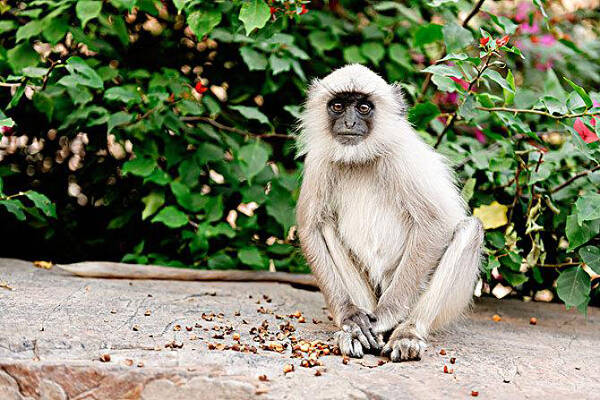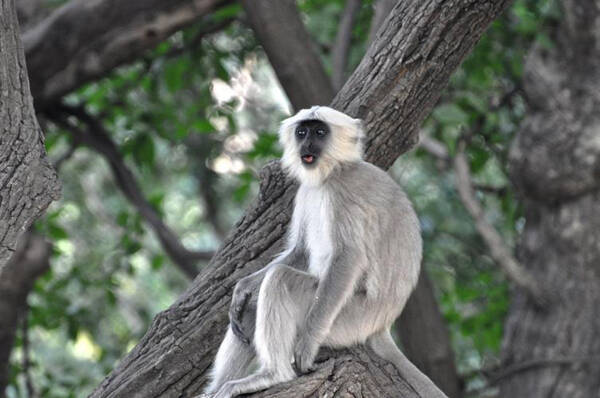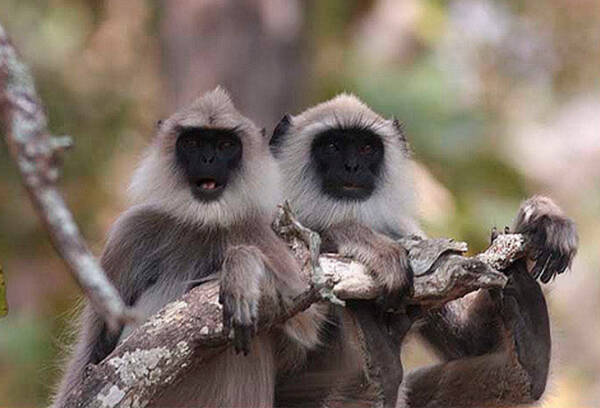Semnopithecus entellus
IUCN
LCBasic Information
Scientific classification
- name:Semnopithecus entellus
- Scientific Name:Semnopithecus entellus,Northern Plains Gray Langur,Northern Plains Gray Langur, Bengal Long-tailed Langur, Hanuman Langur
- Outline:Primates
- Family:Cercopithecidae G.Langur
Vital signs
- length:58.5-64cm
- Weight:9.9-13kg
- lifetime:About 20 years
Feature
The cheek hair and eyebrows are well developed, and the name is derived from the length of the body or tail.
Distribution and Habitat
Origin: India (Bihar, Orissa); Introduced: Bangladesh.
The Indian Gray Langur is adapted to a wide variety of habitats, from the arid areas on the edge of the desert in Rajasthan, India, to the tropical evergreen rainforests of the Western Ghats. It is also found and lives near human settlements, including the Indian city of Jodhpur, where there are a million of them (2008). It is found from 100 m above sea level to 4270 m above sea level in the Himalayas. It is a forest-dwelling primate in India, but in Bangladesh it lives in open forests. Rainfall in its habitat varies greatly, ranging from 10 to 200 cm. The species can withstand a wide range of temperatures, from -7˚C to 46˚C. It is a ground-dwelling species, spending 80% of the day on the ground.
Appearance
The Indian gray leaf monkey is about 58.5-64 cm long and weighs 9.9-13 kg. Its tail is more than 100 cm long and has well-developed cheek hair and eyebrows. It is named after its body length or tail length. Its body hair is mainly brown and gray, with red on the back and white fur on the belly. There are some grayish-white hairs on the forehead that radiate in a spiral shape. The feet, hands, face and ears are black, and there is a circle of white hair on the cheeks. There is a crown on the top of the head. The eyebrows grow forward and are also very long. There are white hairs on the head, face, chin and throat, and it looks quite handsome. The skin is pale at birth, but it turns black before three months; the hair color is also different from that of adults, which is brown-black, and becomes light gray when it is two to five months old, and then gradually turns into yellow-brown, and only turns into gray-yellow-brown when it is adult. The head is round, the snout is short, and the li
Details
Indian Gray Langur (scientific name: Semnopithecus entellus) is called Northern Plains Gray Langur in foreign language, and has no subspecies.

Indian Gray Langurs usually like to form small groups of more than ten or large groups of nearly 100, and spend 5 hours a day grooming each other. The call is relatively low, often making a "woop" sound, which is not only a signal for communication between members, but also a warning to other neighboring populations to occupy territory. Whether running on the ground or jumping on branches, it always bends its long tail high up, which looks very impressive. It has a high jumping ability, often jumping more than 8 meters, and can easily jump from a 12-meter-high tree to the ground.
Indian gray leaf monkeys often appear on the cliffs in the forests on both sides of the river valley, but they also like open places. They often gather in large groups, up to hundreds of them. Each monkey group occupies an activity range of about 30 to 60 square kilometers. The activity ranges of each group can overlap, and they live in harmony. Even if two groups meet on the same tree, they will not fight. Each group has its own central area of activity, including sleeping trees, favorite trees and water sources. Some monkey groups are all male monkeys, and some are both male and female groups. If a single male monkey breaks into a group of both sexes, the head monkey of the group will immediately attack and drive away the intruder. In the group of both sexes, the head monkey of the male monkey often changes. This kind of male monkey takes a "superior" attitude, bullies the weak, and acts arrogantly. However, the little monkeys are treated preferentially and can avoid being beaten or bullied.

Indian gray leaf monkeys forage mostly in the morning and evening, mainly eating various leaves and buds, accounting for about 54% of the total food, flowers account for about 5% of the food, and fruits account for about 37%. Indian gray leaf monkeys in different places can go without water for several months in the dry season, because in addition to taking water from plants, they can also drink their own urine to quench their thirst. Indian gray leaf monkeys like to eat a variety of fruits, leaves, buds, flowers, etc. People living near human settlements sometimes raid gardens and crops. Tribes living near temples rely on food given by humans. In the snowy winter in the Himalayas, they rely on the bark and branches of pine trees to fill their stomachs. They usually come out to forage after the sun rises, take a long rest at noon, move around and eat in the afternoon, and return to the trees to sleep in the evening.
The gestation period of females is about 168-196 days, with one baby born per litter, and the lactation period is 2 years. Indian gray leaf monkeys that live in high mountain areas give birth in April every year. Before the cold winter comes, the baby has grown up and can basically live independently. Indian gray leaf monkeys living in tropical areas can give birth all year round. Newly born cubs are dark brown with pink faces, which are different from adults. They turn black after 3 months. Females reach sexual maturity at 4 years old, while males reach sexual maturity at 6 years old.

In India, the Indian gray langur is also known as the "holy monkey" or "monkey god". The "Monkey King" Hanuman, who was created based on the Indian gray langur, is the protagonist of a famous local myth. Like Sun Wukong in the Chinese myth "Journey to the West", it is also extremely powerful, boundless, good at changing, able to fly in the clouds, etc. Therefore, it is deeply loved by people. People worship it as a god and dare not "disobey" or neglect it at all, always letting it "come happily and leave satisfied". Therefore, the Indian gray langur there enjoys many "privileges" and can wander around in the streets, shops, temples and other places in cities and villages, and even move freely anywhere. They run around everywhere, often begging for food from pedestrians, and sometimes go to shops to eat and drink. Especially in temples, they often act arrogantly, as if they have become the masters there.
As recently as 2006, thousands of Indian gray langurs that escaped from the forests near the Indian capital New Delhi often swarmed into the city, causing great trouble to the citizens. They broke into New Delhi's residential and work areas, crawled around homes and offices throughout the city, and "chatted" in trees, streets, and rooftops. Because no one stopped them, they gradually became addicted to the alcohol that was placed in the tax department's laboratory for testing. If they couldn't get the alcohol to drink, they would make a scene in the office building to vent their anger. Their behavior also disrupted the normal operation of government work, and they even broke into the heavily guarded presidential residence and did whatever they wanted in the nearby offices of the Ministry of Foreign Affairs and the Ministry of Defense, tearing up and taking away important documents. It was really lawless to the extreme.
Listed in the 2008 Red List of Threatened Species of the World Conservation Union (IUCN) ver 3.1 - Least Concern (LC).
Protect wild animals and eliminate game.
Maintaining ecological balance is everyone's responsibility!








